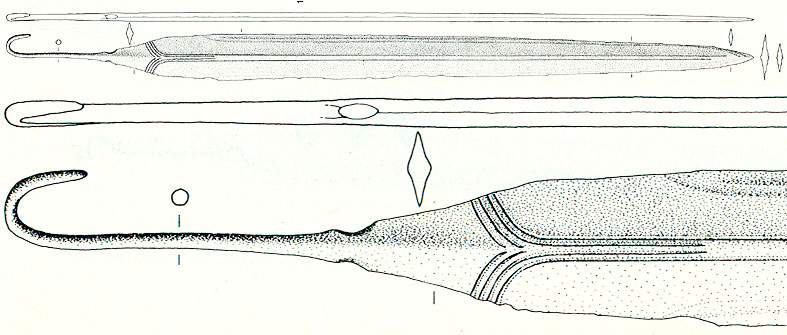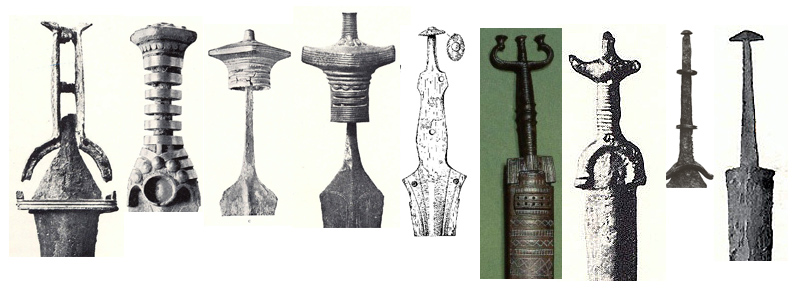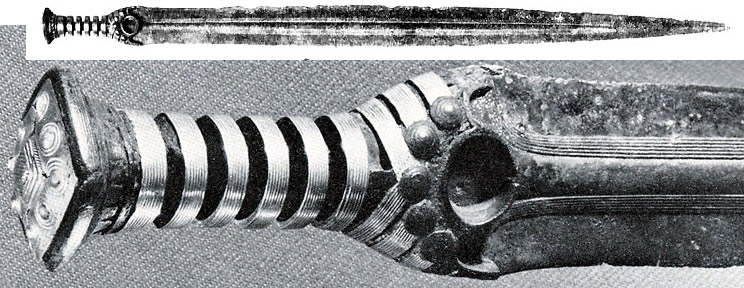| Author |
Message |
|
Steve L.
|
 Posted: Sat 29 Jul, 2006 3:52 am Post subject: Posted: Sat 29 Jul, 2006 3:52 am Post subject: |
 |
|
|
As i sayed: The cast-over-cast-method (i don´t know then english word for "Überfangguss") was not very common for the northern bronze swords! The common way was the from Dan discribed.
|
|
  |
 |
Kirk Lee Spencer

|
 Posted: Sat 29 Jul, 2006 9:28 pm Post subject: Posted: Sat 29 Jul, 2006 9:28 pm Post subject: |
 |
|
| Dan Dickinson wrote: | ...Oakeshott states that a tang was tried and rejected for bronze age swords. Is this then another later attempt that survived and thus led to iron age construction methods, or is it perhaps the attempt that he is referring to?...
Dan |
Hey Dan...
I had the same idea awhile back and wondered it some of the Full/Solid hilted swords (Vollgriffschwert) with tang-through-the-grip type construction were not the precursor to the pommel piece spikes with tang buttons of the Hallstatt C sword and then to the tang buttons of the LaTene which set the stage for peened tangs throughout the rest of the history of the sword... 
If this progression has merit, then Oakeshotts comment about the rejection or failure of the experiment of the tang construction is somewhat confusing. Maybe he is speaking from an English point of view, and the experiment was in the southern part of Britain, with swords such as the Salcombe Devon Shipwreck find... (see attachment) I think it is about 1100 BC? That would put it a couple of centuries after the Danish rod hilted swords (Griffangelschwert)  . .
I put together a progression of the peened tang... From bronze to migration... Be sure and let me know where my chronology is off... I am working mainly from a design point of view.
ks
 Attachment: 72.05 KB Attachment: 72.05 KB

Rod Tang Sword Length 64cm Max Width 41mm Salcombe Devon Shipwreck from "The Swords of Britain" by Colin Burgess and Ian Calquhoun in Prahistorishe Bronzefunde Abteilung IV, 5 band
 Attachment: 98.32 KB Attachment: 98.32 KB

Two swords
Lit in Eden’s flame
One of iron and one of ink
To place within a bloody hand
One of God or one of man
Our souls to one of
Two eternities
|
|
  |
 |
Mikko Kuusirati

|
 Posted: Sun 30 Jul, 2006 3:42 am Post subject: Posted: Sun 30 Jul, 2006 3:42 am Post subject: |
 |
|
Kirk, can you tell more about the second sword from the left in the second image? I absolutely love the hilt form, but know practically nothing about this time period.
"And sin, young man, is when you treat people like things. Including yourself. That's what sin is."
— Terry Pratchett, Carpe Jugulum
|
|
  |
 |
Kirk Lee Spencer

|
 Posted: Sun 30 Jul, 2006 3:41 pm Post subject: Posted: Sun 30 Jul, 2006 3:41 pm Post subject: |
 |
|
| Mikko Kuusirati wrote: | | Kirk, can you tell more about the second sword from the left in the second image? I absolutely love the hilt form, but know practically nothing about this time period. |
Hi Mikko...
I agree that is a beautiful hilt... (and the blade is really nice too) Although I have never seen a color picture of it, it the bands decorating the hilt and lower guard appear to be gold, with engraved gold in the pommel.
Don't feel bad about knowing little about the period, it seems that very few people do. However, IMHO, this period... the Nordic Bronze Age has some of the most astonishingly beautiful bladed weapons.
The Nordic Bronze Age that flourished on the western shores of the Baltic is a very old culture (beginning about 1700 B.C. to roughly 600 B.C.) Archeologist believe that at this time the climate was warmer in this region. The amber trade flourished which provided capital and trade connections with the Mycaneans, Villanovians in Italy, possibly even the Phoenicians and Egyptians. This made for a very rich and varied mix of influences reflected in the amazing artistry of their material culture. The Culture declined as the climate grew colder and wetter. As many of these tribes moved southward they formed the core of proto-germanic culture and eventually many of the Germanic tribes. It is interesting to me, in this connection, that the composite or compound grips (grips made of metallic rings with some form of organic material between) seen on some of the Nordic BA rod tang swords can also be found on some of the late LaTene swords and I have heard that this was do to increasing germanic influence in the Celtic design. Of course, we are talking about a reappearance after over a thousand years... but it is worth noting that it is coming roughly from the same region. In paleontology they call it the "Lazarus Effect". Not sure how or why it occurs.
The Danish bogs have also allowed excellent preservation.... in some cases with wood and leather components.
One of the best internet resources for seeing these finds is:
http://www.guderoggrave.dk/
Click on "Genstande"
Then click on "Vaben"
Then Click on "Svaerd"
Click on any grouping under Svaerd heading
Click on red "SOG" at bottom
Click on image to see larger version
Click on "flere billeder" to see detailed images.
ks
 Attachment: 99.67 KB Attachment: 99.67 KB

Image from "Vorgeschichte der deutschen Stamme" by Dr. Hans Reinert
 Attachment: 36.36 KB Attachment: 36.36 KB

Late LaTene composite grip. Detail from and image by Jeroen Zuiderwijk
Two swords
Lit in Eden’s flame
One of iron and one of ink
To place within a bloody hand
One of God or one of man
Our souls to one of
Two eternities
|
|
  |
 |
Mikko Kuusirati

|
 Posted: Sun 06 Aug, 2006 4:57 pm Post subject: Posted: Sun 06 Aug, 2006 4:57 pm Post subject: |
 |
|
Thank you! A most informative answer. I'll have to look into this period some more, the more I know the more it intrigues me...
Would you happen to know how this particular hilt is constructed? Full tang, peened under or though the decorative (gold?) plate? Those five large rivets at the shoulder, are they used to fix the hilt to the blade, or just the decorative bands to the hilt?
"And sin, young man, is when you treat people like things. Including yourself. That's what sin is."
— Terry Pratchett, Carpe Jugulum
|
|
  |
 |
|
Jeroen Zuiderwijk
Industry Professional
|
 Posted: Mon 07 Aug, 2006 5:19 am Post subject: Posted: Mon 07 Aug, 2006 5:19 am Post subject: |
 |
|
| Kirk Lee Spencer wrote: | Hey Dan...
I had the same idea awhile back and wondered it some of the Full/Solid hilted swords (Vollgriffschwert) with tang-through-the-grip type construction were not the precursor to the pommel piece spikes with tang buttons of the Hallstatt C sword and then to the tang buttons of the LaTene which set the stage for peened tangs throughout the rest of the history of the sword...  |
The problem is that the swords went extinct in the Hallstatt D period. So the Mindelheim swords lead to a dead end in sword development, and were replaced by short daggers. I'm still looking for evidence that outside the Hallstatt culture, swords had continued their developement, and then moved back into the rest of Europe with the La Tene culture. At any rate, the rod-tang was use in Northern Europe at least until the end of the bronze age (900-700BC). After that period, my knowledge ends. So I have no idea of they went to produce the same swords in Iron, like they did with the Gundlingen swords in the UK and west/central Europe. But the overal construction and style some of these Nordic LBA swords was very similar to the La Tene swords.
|
|
   |
 |
|
Jeroen Zuiderwijk
Industry Professional
|
 Posted: Mon 07 Aug, 2006 5:21 am Post subject: Posted: Mon 07 Aug, 2006 5:21 am Post subject: |
 |
|
| Mikko Kuusirati wrote: | Thank you! A most informative answer. I'll have to look into this period some more, the more I know the more it intrigues me...
Would you happen to know how this particular hilt is constructed? Full tang, peened under or though the decorative (gold?) plate? |
From other examples of this type of sword, without the gold plating, the tang is peened at the back of the hilt. There are full-griff swords where the tang does not extend through the back of the hilt, but those are of a different type. I suppose the plating is applied after the peening, so it will cover it.
| Quote: | | Those five large rivets at the shoulder, are they used to fix the hilt to the blade, or just the decorative bands to the hilt? |
They are used to fix the blade to the hilt, at least judging from exampels where the hilt was made from an organic material (except the pommel, which usually is bronze). So I suspect the same holds for the fully bronze hilted versions.
And welcome to the club of bronze addicts  N.b. for those wanting to explore the fascinating period of the bronze age, definately pay a visit to the Bronze Age Center: http://s8.invisionfree.com/Bronze_Age_Center/index.php. N.b. for those wanting to explore the fascinating period of the bronze age, definately pay a visit to the Bronze Age Center: http://s8.invisionfree.com/Bronze_Age_Center/index.php.
|
|
   |
 |
|
|
You cannot post new topics in this forum
You cannot reply to topics in this forum
You cannot edit your posts in this forum
You cannot delete your posts in this forum
You cannot vote in polls in this forum
You cannot attach files in this forum
You can download files in this forum
|
All contents © Copyright 2003-2024 myArmoury.com — All rights reserved
Discussion forums powered by phpBB © The phpBB Group
Switch to the Basic Low-bandwidth Version of the forum
|

